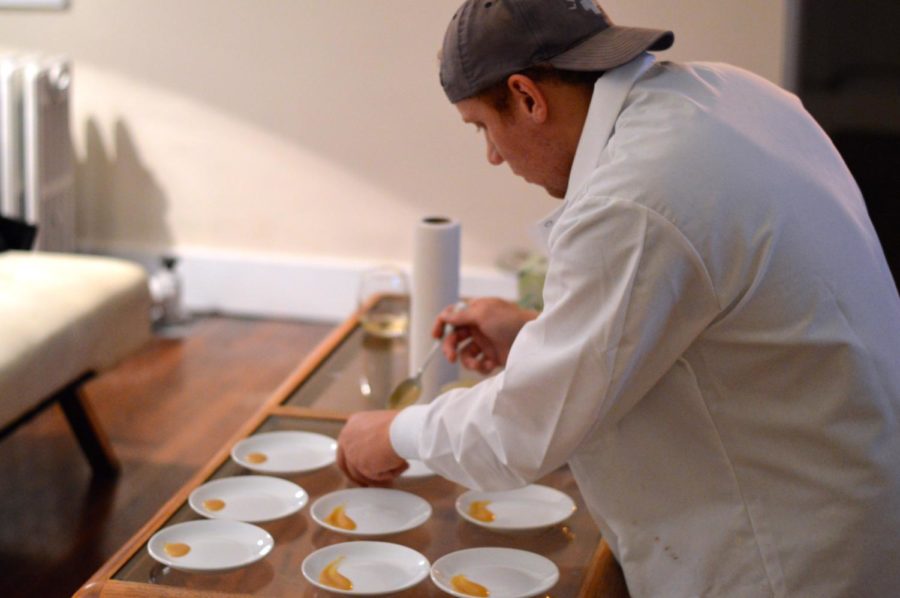Nous is the Greek word for mind, or intellect. It also puns nicely with the French for “us”. As in, come eat with us—food cooked from the heart, with the spirit of rigorous inquiry.
This year, Nous is taking Hyde Park apartment cooking to its limit. We’ve experimented heavily with fermenting, pickling, and aging foods—techniques that, outside of initial prep work, require very little labor. We aim to maximize convenience without sacrificing quality.
We’ll walk you through the fruits of our November 5 pop-up dinner, specifically our kimchi and pork belly. It’s a combination familiar to Korean culture, and with good reason: The tart, funky kimchi cuts the richness of the pork belly, while the savory-sweet meat mellows out the heat of the kimchi.
The goal with the following recipes is for you to develop comfort and intuition with food over time. Ingredient amounts are left ambiguous as the recipes are flexible: As you prepare them (hopefully over and over!) you’ll develop a sense for what the dish should look, smell, and even sound like at each stage. We think of home cooking as a self-guided process of discovery—an approach far more versatile and useful than religiously following cookbooks.
Kimchi:
Cooking by the season means affordability. Kale is in season, and similar to other tough greens (think mustard greens, collard greens, and the like); its fibers need to be broken down, either through prolonged heating or—as we explore here—fermentation. The key here is to salt the kale after briefly boiling it, so that the excess water may be drained off. Don’t be impatient, or else you’ll get a soupy, sriracha-y, veggie mess.
You’ll Need:
Kale
Sriracha
Fish sauce
Sugar
Salt
Garlic, minced
Spring onion, coarsely chopped
Airtight container, for pickling
Prep:
Only two elements of this recipe require work: blanching the kale and preparing the fermentation paste. Blanching is briefly submerging your produce into boiling water to break down fibers and kill any bacteria that washing under cold water did not rinse away. We recommend a minimum of five seconds and a maximum of 30 seconds to blanch. Transfer the blanched kale onto ice to stop the residual heat from overcooking. Heavily salt the kale and set aside for anywhere from thirty minutes to a few hours—you’ll want to wring out much of the excess water so that the finished kimchi is crisp. Rinse off the excess salt and give the leaves one last squeeze.
Tip: the longer the blanch, the more tender the kale.
Using a large bowl, mix sriracha, fish sauce, sugar, and salt until it forms a paste. Taste often, adjusting according to preference. You should have enough to generously cover the kale. We also added minced garlic, black radish, and green onions (cut into thin slices) for added flavor and crunch.
Tip: Sriracha and fish sauce kickstart the fermentation: The more you add, the faster the kimchi will pickle. Adding sugar will also accelerate the fermentation process.
Tip: Black radish and green onions release water, which helps thin out the fermentation paste. Add sparingly (or not)!
Tightly pack the solids into airtight jars. You want to leave as little air in the container as possible—add brine from the bottom of the bowl that you vigorously mixed the kale with the fermentation paste in, if needed. Be careful if you’re using a glass container: Fermentation creates carbon dioxide gas thanks to the *lactobacillus* bacteria. Open the container every other day to release built-up gases. Let sit in the fridge for at least a week.
Tip: Fermentation produces the sour, funky taste of a pickle. Keeping the kimchi fermenting for longer accentuates those flavors.
Pork Belly:
When I heard that pork belly was high in supply and only $3.99 to $4.99 a pound, I jumped on the opportunity. It is tricky to cook, with alternating layers of tough flesh and fat. We want to a) render out as much fat as possible and b) keep the flesh tender, but supple. The key here is to cook the pork twice: first at a lower temperature to render the fat, then at a higher temperature to crisp the skin. We also used hoisin sauce to flavor the pork, although any other sweet sauce works just as well (sorry not sorry, ranch).
You’ll Need:
Pork belly
Salt
Hoisin sauce or similar, like teriyaki
Prep:
This recipe leaves most of the heavy lifting to the oven, so focus on preparing the skin and adjusting the temperature. Score the skin of the belly with a knife, cutting to just above the flesh so the fat has more surface area to render. Cut across the entire surface of the pork belly in one direction, then repeat at a perpendicular angle: Your pork should have a nice, even surface grid. Salt generously.
Tip: Salting the skin releases water, which helps the belly crisp up better in the oven. For best results, leave pork in fridge—uncovered—overnight after salting and patting dry with paper towel.
Bake the pork belly skin-side up at 250–300F for two hours first. (Remember to preheat the oven!) Then, crank up the temperature to 450–500F to crisp and color the skin.
Cut the pork belly into half-inch slices. Coat slices thinly in sauce, shaking off the excess. In a very hot pan, flash sear both sides of the pork belly in oil, 15–30 seconds each. You should hear an immediate, aggressive sizzle: The goal is to caramelize the sugar in the sauce and brown the inside of the meat.
Tip: Cutting the pork belly against the grain yields a tender cut of meat that doesn’t fall apart.
Tip: Add a spritz of lime juice or ponzu sauce in the pan while searing to add a refreshing, acidic note—this cuts down the richness of the pork.
Bon appétit!









